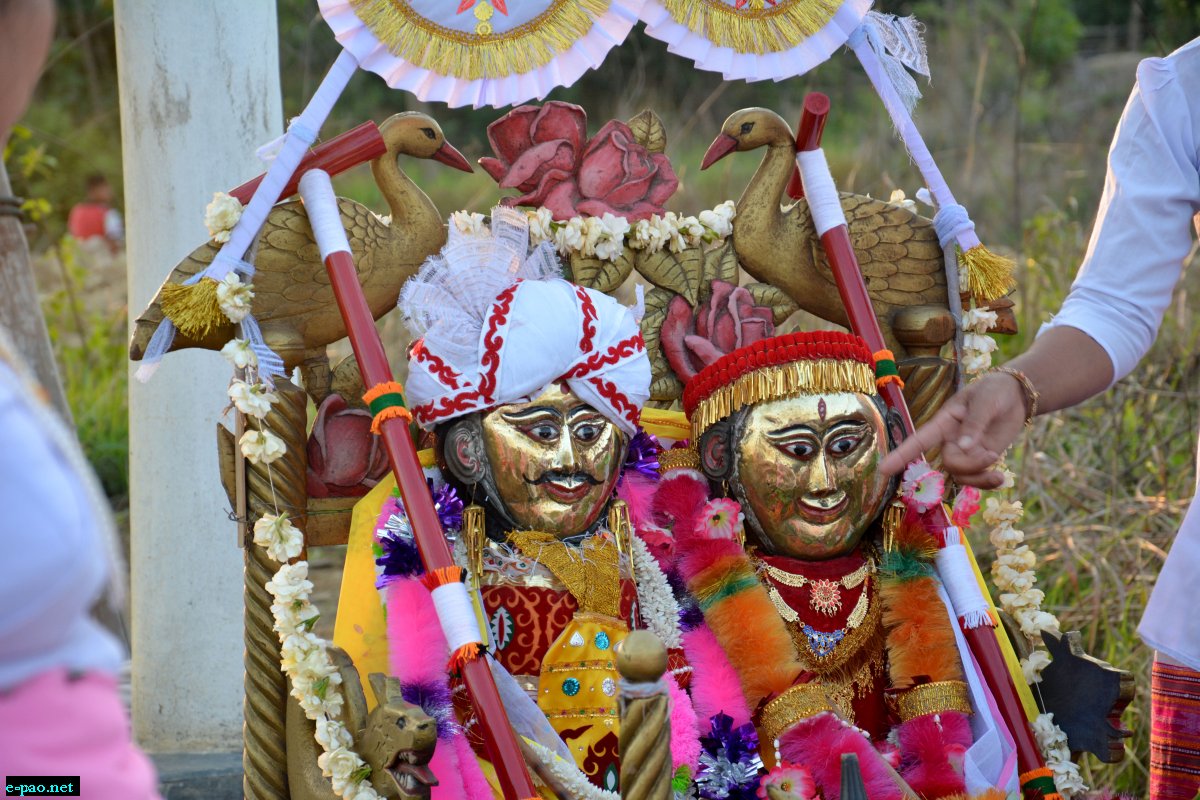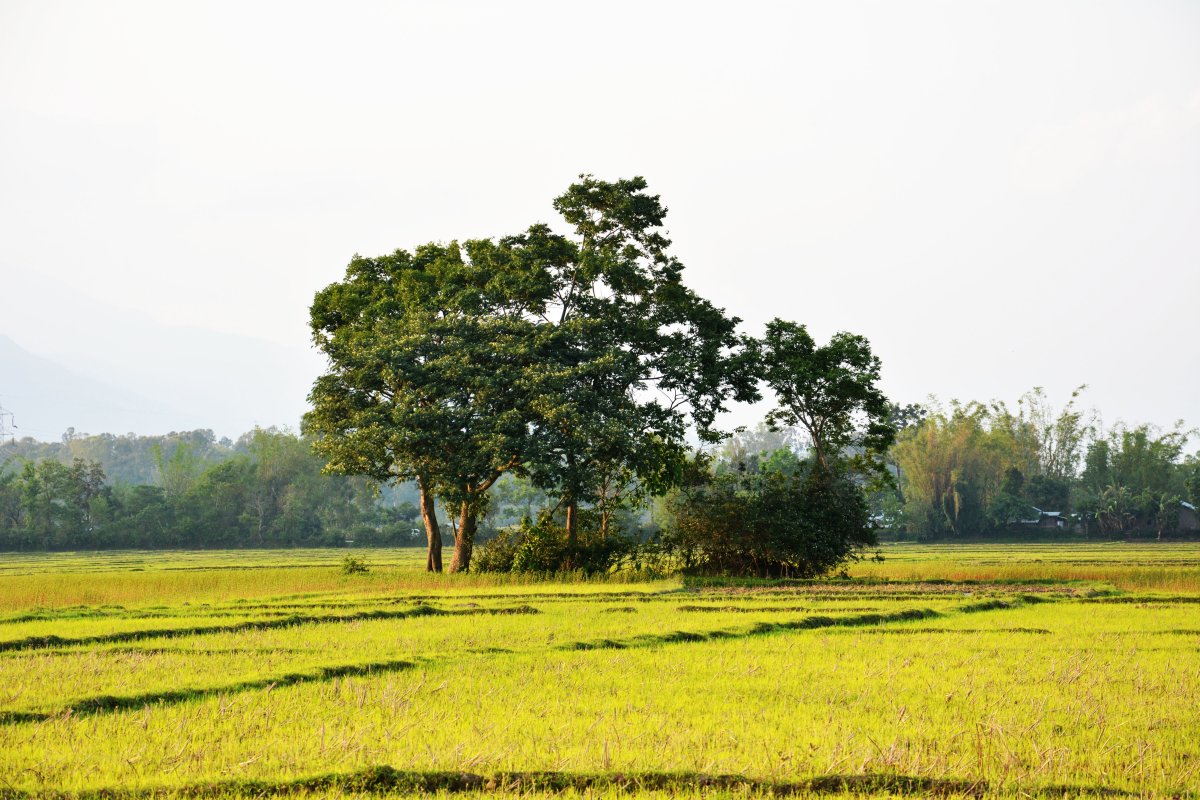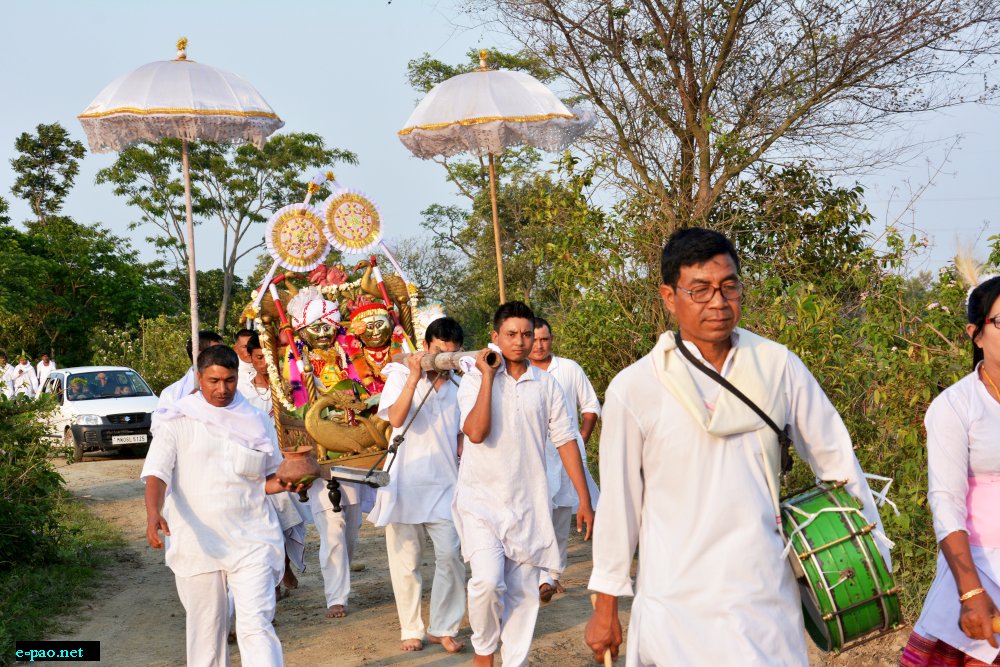Ibudhou Oknarel and Macha Ibemma Khudithibi of Ningthoukhong
R.K. Birjit Singh *

Ibudhou Oknarel of Ningthoukhong
The sound of the drums of *Iputhou Oknarel Haraoba, ricochets since time immemorial, re-creating the creation myth of the earth as believed by the Meitei, depicting the different aspects of life of humankind right from birth till death and the deity is one of oldest forest deities of Manipur who introduced the domestication of rice in the valley with the living testimony in its ancient plot of paddy field "Khunu Pamfen Lou" as the wild rice seeds were extracted from the crop of a wild pigeon and sown in this plot.
The ancient plot of paddy field is still lying unnoticed to the modern world waiting only to be engulfed by the jaws of time flanked by "Pengba Yakathen", in the southern side, the den or the congregation site of Pengba, Ray–finned fish, (Osteobrama belangeri) the flagship fish species of Manipur migrating from Chindwin river through Loktak Lake.
Ibudhou Oknarel of Ningthoukhong is one of the most revered forest deities of Manipur. In the palace of Manipur, Ibudhou is known as "Lai Hanuba" (Grand old deity). People of Manipur, particularly, the Rongmei tribes and Meitei had been worshipping Ibudhou Oknarel and his daughter goddess Macha Ibemma Khudithibi since time immemorial at their respective sanctum-sanctorum in Ningthoukhong and at the sacred forest groves of Khudithibi neighbouring with Sadu khuroi village of Churachandpur district in Manipur.
When we talk about forest deities of Manipur, it comes to the proto Meitei concept of the origin of human being and its settlement at Koubru Mountain. Another school of thought of historians of Manipur is the "Sanamahi Laining" which was considered as the very beginning of evolution of the earth from the cosmos.
Whatever may or might be the concept of dichotomies of evolution, the analogy clearly tells us that the cosmogony of belief and thought of Meitei is that the evolution of human settlements in Manipur originated from Koubru peak and later descended downward gradually to the foothills and then to the valley of Manipur.
" Awang Koubru Asuppa,
Leima-Lai Khunda Ahanba,
Nongthrei Ma-u Lingliba,
Irik Mapan Thariba,
...... Lainingthou- O!"
"Oh! Almighty Koubru the guardian of the North,
Where the first settlement evolved,
And Nongthrei seeds be sown,
The origin of nine rivers,
I pray to Thee....."
In the misty landscape of the peak along with the cloud is the abode of Lord Koubru, the holy place of the people of Manipur where the various clans and tribes were believed to have been originated. Earlier there was a vast expanse of water and earth was submerged under water. At the time of creation, the Taibang Mapu (Creator) draws up earth to form hills.
These hills were Koubru, Nongmaiching, Thangjing and Wangbrel which forms the foundations of the world. Koubru was the first to be drawn and represents the head in the bio-physical structure of the land. Rivers originated from these hills form the arteries of the body and Loktak Lake as the pelvic zone.
Oral tradition occupies an important place among the folk and indigenous societies. These oral treasures, belief systems and practices are deeply woven into the life and culture of Meitei people. Manipur abounds in many folk stories. In an attempt to understand the environment and the forces of nature, ancient Meitei discovered stories to account for the things that went on in their lives.
The legendary folklore of Ibudhou Oknarel begun at the lofty mountain ranges of Koubru and has been considered as the incarnation of Lord Koubru himself. Some scholars mentioned Ibudhou Oknarel as the son of Lord Koubru and others as the incarnation of Lord Sanamahi. According to the legend, Ibudhou was a mighty player of Polo, a great thrower of spear and highly skilled in combat spear fight and a sharp shooter of bow-slingshot (Shairong).

Khunu Pamfen lou
The great adventurous forest deity travelled to find a new place crossing the rolling blue mountains of Koubru through Leimaton hill ranges and arrived at Thingpui village (now Laimanai Kabui) and there he performed Ta-Khousaba, a somatic exercise of systematic wielding of spear (the art of combat spear fight) under a big tree nearby a stream to mark his arrival and drive away evil forces. Ibudhou flexed and exercised Laan-Yengba (gesture of looking around in search of enemy) and Laan-Koiba (gesture of encircling the enemy).
The stream where Ibudhou exercised and performed Ta-khousaba is known as Khousa-lok now diluted to "Khujairok". Being alarmed by the arrival of unknown power in the form of storm carrying aura who he had never been reckoned in the nearby area of his dominion, Ibudhou Thangjing rushed to the northern site near the foothills, where he met (Oknare) Ibudhou Oknarel.
The grand meeting of the two great forest deities conceived the incarnation of Lord Koubru as Oknarel (Oknare = Met; Rel =Grand: Grand Meeting) or the foremost meet. The two great power's showdown of their physical strength (Thengnare or Sathengnare) or grand challenge gave birth to another name "Thengnarel". So, the name of Ibudhou Thangnarel is derived from a phonological change or dilution from "Thengnarel". Thus a metaphorical name of Oknarel and Thangnarel had been born like two faces of the same coin.
The physical and sanctimonious challenges and showdown of the two great deities had emancipated and recognized themselves as two brothers and Ibudhou Thangjing extended a cordial and heartfelt welcome to his elder brother Ibudhou Oknarel and invited him to Kege Moirang Leipak. Leaving his mission to find a fertile dry land, Ibudhou Oknarel went following Thangjing koirellai in the foothills.
Ibudhou Oknarel spent a good time there at Kege Leipak (land of Kege) with Thangjing and returns back at Sadukhuroi and took rest at Uwung pareng (Rows of Oak tree) on the gateway of the village (Sadu Khunman). Still now the Rongmei brethren of Sadu village are offering annually flowers, fruits, rice, chicken, pig and others items of fish and animals. Here one can trace the blood relationship amongst the present different ethnic groups of the hill and valley of Manipur having originated from same bloodlines.
Ibudhou stayed amongst the Kabui(Rongmei) women hiding himself in the form of human being in the face of a young Haoba Tangkhul. As the days pass and gone by, Ibudhou was married to Khunbuleima (Khuningthou Tompokhanbi) daughter of the Sadu village Khullakpa (Headman) after a secret divine relationship. Ibudhou joined the normal activities of the peasant's ancient nomadic village life like hunting, cultivation, fishing and cutting of firewood besides caring for his newly born daughter Macha Ibemma and his wife.
Ibudhou joined Ibendhou in community spading of pamlou (Slope land) for cultivation of crops for each of the family in their respective fields or cultivable land. When the turn for spading the field of Ibudhou came, the community started asking as where is his field to spade, Ibudhou drawn his spear flexing his arm and threw towards the South-Eastern side telling them that the place where the spear lands shall be his field.
The peasant community (Khullang) of Sadu came down with Ibudhou towards the valley and took rest for a while there at Tu-khang Ching now known as Dolaithabi while trying to find the spear. They found the spear at Lamlemumang behind Ningthoukhong Kha khunou area and together they spaded the land.
While the peasants were resting for a little while after spading, enjoying the foods they brought, Ibudhou set out towards South-West direction at Terapokpi in between Ningthoukhong Kha khunou and Thinungei near Laimanai and shot a wild pigeon "Lam khunutharikpi" better known as "Leimakhunu"(Burmese spotted dove Streptopelia chinensis) sitting on the branch of a Tera tree (Silk cotton tree Bombax ceiba) flying from Ithat-chingithing (Ithing Island) regarded as the messenger of almighty with his bow-slingshot.
Ipudhou Oknarel extracted the wild rice seeds found inside the crop of the pigeon and sowed it in the field together with peasants of Sadu. Still today seedling and transplantation of rice cultivation were done after the ritual seed sowing ceremony of Ipudhou Oknarel at Khunu Pamfenlou by the surrounding villagers.
Iputhou Thangjing borrowed rice seed from his elder brother and introduced domestication of rice at Keke Moirang and there were the tradition of returning the rice after harvesting during Lai Haraoba. Still Iputhou Thangjing of Ithing is following the tradition of returning rice during Iputhou Oknarel Haraoba.
The domestication of rice in the valley of Manipur had been mentioned in the old scriptures of Manipur (Puya) like in Kangparon (the account of Kangba dynasty), Poireiton Khunthoklon, mythical accounts of the migration of Poireton to the valley. They are respectively Morshy Thangyi or weedy rice (Oryza sativa f. spontanea), Tongnu Mathi, Likshi Khalil Mathi, Yaisel Yao Phou Mathi and Chakchal Chahao Mathi. "Mathi" is referred to here as seed.
These paddy seeds were believed to be brought first by Poireiton, an immigrant from the far-east and sometimes referred as the progenitor of the clans of Khuman and Luwang. According to the Phougourol hymn, Phouoibi, the goddess of domesticated rice came to the valley from Khamnung with Poireiton.
In the ritual songs sung by the Amaibi's and amaiba's in the Lai Haraoba, there is a reference that the earliest ancestors cultivated a variety of wild rice called Wainu chara. The wild rice species is still growing at Keibul Lamjao and at Thangjing kom, Thinungei, one of the 9 sacred water bodies of Loktak Lake as per Moirang Kangleirol.
As the level of water in the valley gradually drops after the domestication of rice at Lamlem Khunu-pamphen-lou, Iputhou set out towards Ningthoukhong to find a dry land for settlement. On the way, Macha-Ibemma stumbled on a hard stone and her big toe was badly injured and copiously bleeding. She could not move even for a little distance.
Ibendhou lamented like a summer tempest in view of the pitiable condition of their only daughter and requested Iputhou Oknarel to do something for their lovely daughter to recuperate. Plucking some herbs, Iputhou with his mighty spiritual power controlled the severe bleeding and removed the pain from his daughter but could not move her from the place.
The place where Macha Ibemma was healed using mythical herb by the divine parent is known as "Napithabi" and surrounding villagers belonging to Rongmei tribes and Meetei and continues to offer leaves of grasses, trees and flowers in the foot of a gigantic oak tree since time immemorial while passing through the area. The hillock is known as "Khudithibi" reminding of the legendary event with a prefix "Macha Ibemma Khudithibi".
All the efforts of the divine parent to take their daughter along with them miserably failed and it became the destiny of Macha Ibemma to remain and reside at the Khudithibi hillock forever.
The heart-breaking wail of the parent reverberate throughout the night at the hillock with the insurmountable pain of the mother lamenting how she raised her during difficult times like any human mother. Shielded from the icy gales from the west, ravaging rainstorms from the above and from the wild forest flames but all the hopes shattered and fallen apart like wasted fruits and withered flowers.
The time for separation came with bottomless misery as the sun started to wake up in the east and Ibudhou Oknarel consoled her daughter and pledged that no occasion will be celebrated without her and to come every year with a lot of food, fruits and other preferred items of his daughter and requested to wait for them at "Kabokthel", a sacred serene meadow before reaching the Khudithibi hillock from Ningthoukhong.

Laiching kaba
Thus every year Ibudhou and Ibendhou together with Amaibas and Amaibis along with the disciples used to visit Khudithibi sitting on a palanquin carrying a lot of food items, fruits, flowers before the commencement of "Haraoba" and "Hiyang Tannaba" as invitation to join the respective ritual festivals and Macha Ibemma Khudithibi used to wait eagerly the visit of her parents at Kabokthel during the period. The visit of Ibudhou Oknarel to Khudithibi is known as "Lai-Chingkaba".
Ibudhou Oknarel went down to Ningthoukhong leaving his lovely daughter and resided amongst the brooks with his betrothed Ibendhou Khunbungambi. Much later on, an epiphany from Ibudhou to one Pee-thadoi, believed to be the ancestors of present Moirangthem clan migrated from Moirang initiated the carving of the idol (Komai) of Ibudhou and Ibendhou and consecrated at the present sanctum-sanctorum in Ningthoukhong.
Thereafter, the rituals of "Lai Haraoba", "Lai-Phou Hunba", Lai-chingkaba" and "Hiyang Tannaba" has been practised with much fanfare till now even though we could not ascertain correctly from which time the rituals originally started.
In the early days, the temple of Ibudhou Oknarel was open for worshipping only to the members of the Royal family of the palace of Manipur during Saturday and Sundays. Nobody have any idea about how Ibudhou Oknarel came to be associated with childless woman. Childless queens and princess of the palace thronged at the shrine of Ibudhou Oknarel during Saturday and Sunday to get blessing and last but not the least was M.K. Binodini Devi who conceived her first child after visiting the shrine spending desperately without child for many years after her marriage.
Still now hundreds of childless woman and devotees come from the different parts of the state to the shrine to get blessing and to quench the thirst of having a child.
Laiharaoba is an ancient Meetei fertility rite celebrating cosmic union between male and female principles and later it enlarged to incorporate cosmological and ideological categories of Meetei nation, assuming an intense complicated ritual theatre structure.
The historicity of Laiharaoba complex with an excellent exposition of dance depicting Hakchang Sagatpa (Making of somatic body), presence of serpent dragon dances, the simulation of the coils of the ancestor serpent dragon father Pakhangba, etc.
The songs and hymns of Hijan Hirao which began in early primitive times with the indigenous belief in the cosmic logic of union of the Sky as Father and the Earth as Mother, an intense belief throughout Asia and Southeast Asia.
Laiharaoba exploits the idea of nature as a vital force attributing the traditional feelings of Manipuri society towards and plants and animals and the nature as a whole. It reveals the age-old tradition of protecting ecosystem. Obviously, worshipping and protection of nature are two different things.
But the basic fact is that our forefathers regarded the preservation of nature as ritual. One may say that it is paganism or tribal custom but they understood the umbilical cord attaching human to the non-human form of nature. It is an act of communicating the nature with utmost admiration. They have always tried to live in harmony with nature.
Our hunt and greed for material achievement and quest for knowledge for development made us alienated from the root of the nature, the cradle of our existence and disconnects us from ecological realities.
* The earlier term "Iputhou" was now corrupted to "Ibudhou"
For this article, research was carried out by M. Joy Singh, Sharat Khumancha, R.K. Romesh Singh, Laishram Dhananjoy Singh, while Late Ojha M. Nilakomol Singh; Late M. Raghumani Kegecha, Phiwangbam Leikai, Moirang; Dh. Gachung, Headman, Thingpui (Laimanai Village); L. Amuba Singh; M. Mukundo Singh, Oknarel Thouganlup Committee; S. Sangai Luwangcha, Ibudhou Sanamahi Thouganlup Committee, Thinungei acted as Consultants.
* R.K. Birjit Singh wrote this article for e-pao.net
The author is Asst. Professor, State Coordinator, Indian Bird Conservation Network (IBCN), Manipur.
Honorary Wildlife Warden, Bishnupur District and member, Manipur Biodiversity Board(MBB), Govt. of Manipur
The writer can be reached at bsningthemcha(AT)gmail(DOT)com
This article was webcasted on May 06, 2019.
* Comments posted by users in this discussion thread and other parts of this site are opinions of the individuals posting them (whose user ID is displayed alongside) and not the views of e-pao.net. We strongly recommend that users exercise responsibility, sensitivity and caution over language while writing your opinions which will be seen and read by other users. Please read a complete Guideline on using comments on this website.








